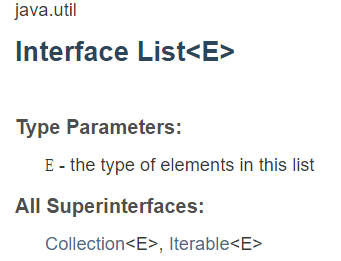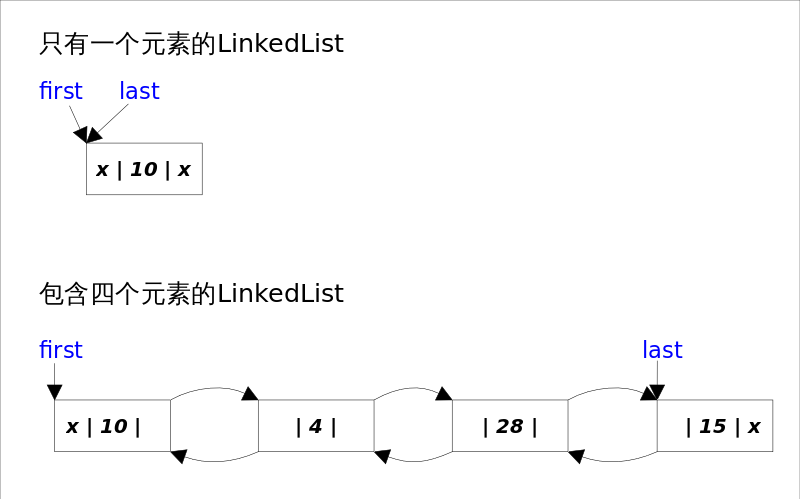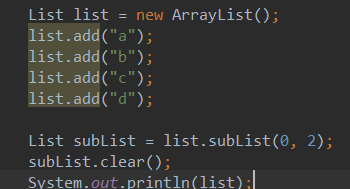Java 集合深入理解(4):List 介面
在 Java 集合深入理解:Collection 中我們熟悉了 Java 集合框架的基本概念和優點,也瞭解了根介面之一的 Collection,這篇文章來加深 Collection 的子介面之一 List 的熟悉。
List 介面
一個 List 是一個元素有序的、可以重複、可以為 null 的集合(有時候我們也叫它“序列”)。
Java 集合框架中最常使用的幾種 List 實現類是 ArrayList,LinkedList 和 Vector。在各種 List 中,最好的做法是以 ArrayList 作為預設選擇。 當插入、刪除頻繁時,使用 LinkedList,Vector 總是比 ArrayList 慢,所以要儘量避免使用它,具體實現後續文章介紹。
為什麼 List 中的元素 “有序”、“可以重複”呢?
首先,List 的資料結構就是一個序列,儲存內容時直接在記憶體中開闢一塊連續的空間,然後將空間地址與索引對應。
其次根據官方文件 :
The user of this interface has precise control over where in the list each element is inserted. The user can access elements by their integer index (position in the list), and search for elements in the list.
可以看到,List 介面的實現類在實現插入元素時,都會根據索引進行排列。
比如 ArrayList,本質是一個數組:
LinkedList, 雙向連結串列:
由於 List 的元素在儲存時互不干擾,沒有什麼依賴關係,自然可以重複(這點與 Set 有很大區別)。
List 介面定義的方法
List 中除了繼承 Collection 的一些方法,還提供以下操作:
- 位置相關:
List和 陣列一樣,都是從 0 開始,我們可以根據元素在 list 中的位置進行操作,比如說get,set,add,addAll,remove; - 搜尋:從 list 中查詢某個物件的位置,比如
indexOf,lastIndexOf; - 範圍性操作:使用
subList方法對 list 進行任意範圍的操作。
Collection 中 提供的一些方法就不介紹了,不熟悉的可以去看一下。
集合的操作
remove(Object)- 用於刪除 list 中頭回出現的 指定物件;
-
add(E),addAll(Collection<? extends E>)-
用於把新元素新增到 list 的尾部,下面這段語句使得 list3 等於 list1 與 list2 組合起來的內容:
List list3 = new ArrayList(list1); list3.addAll(list2);
注意:上述使用了
ArrayList的轉換建構函式:public ArrayList(Collection
-
Object 的 equlas() 方法預設和 == 一樣,比較的是地址是否相等。
public boolean equals(Object o) {
return this == o;
}
因此和 Set,Map 一樣,List 中如果想要根據兩個物件的內容而不是地址比較是否相等時,需要重寫 equals() 和 hashCode() 方法。 remove(), contains(), indexOf() 等等方法都需要依賴它們:
@Override
public boolean contains(Object object) {
Object[] a = array;
int s = size;
if (object != null) {
for (int i = 0; i < s; i++) {
//需要過載 Object 預設的 equals
if (object.equals(a[i])) {
return true;
}
}
} else {
for (int i = 0; i < s; i++) {
if (a[i] == null) {
return true;
}
}
}
return false;
}
@Override
public int indexOf(Object object) {
Object[] a = array;
int s = size;
if (object != null) {
for (int i = 0; i < s; i++) {
if (object.equals(a[i])) {
return i;
}
}
} else {
for (int i = 0; i < s; i++) {
if (a[i] == null) {
return i;
}
}
}
return -1;
}
兩個 List 物件的所有位置上元素都一樣才能相等。
位置訪問,搜尋
基礎的位置訪問操作方法有:
get,set,add,remove- set, remove 方法返回的是 被覆蓋 或者 被刪除 的元素;
indexOf,lastIndexOf- 返回指定元素在 list 中的首次出現/最後一次出現的位置(獲取 lastIndexOf 是通過倒序遍歷查詢);
addAll(int,Collection)- 在特定位置插入指定集合的所有元素。這些元素按照迭代器 Iterator 返回的先後順序進行插入;
下面是一個簡單的 List 中的元素交換方法:
public static <E> void swap(List<E> a, int i, int j) {
E tmp = a.get(i);
a.set(i, a.get(j));
a.set(j, tmp);
}
不同的是它是多型的,允許任何 List 的子類使用。 Collections 中的 shuffle 就有用到和下面這種相似的交換方法:
public static void shuffle(List<?> list, Random rnd) {
for (int i = list.size(); i > 1; i--)
swap(list, i - 1, rnd.nextInt(i));
}
這種演算法使用指定的隨機演算法,從後往前重複的進行交換。和一些其他底層 shuffle 演算法不同,這個演算法更加公平(隨機方法夠隨機的話,所有元素的被抽到的概率一樣),同時夠快(只要 list.size() -1 )次交換。
區域性範圍操作
List.subList(int fromIndex, int toIndex) 方法返回 List 在 fromIndex 與 toIndex 範圍內的子集。注意是左閉右開,[fromIndex,toIndex)。
注意! List.subList 方法並沒有像我們想的那樣:建立一個新的 List,然後把舊 List 的指定範圍子元素拷貝進新 List,根!本!不!是!
subList 返回的扔是 List 原來的引用,只不過把開始位置 offset 和 size 改了下,見 List.subList() 在 AbstractList 抽象類中的實現:
public List<E> subList(int start, int end) {
if (start >= 0 && end <= size()) {
if (start <= end) {
if (this instanceof RandomAccess) {
return new SubAbstractListRandomAccess<E>(this, start, end);
}
return new SubAbstractList<E>(this, start, end);
}
throw new IllegalArgumentException();
}
throw new IndexOutOfBoundsException();
}
SubAbstractListRandomAccess 最終也是繼承 SubAbstractList,直接看 SubAbstractList:
SubAbstractList(AbstractList<E> list, int start, int end) {
fullList = list;
modCount = fullList.modCount;
offset = start;
size = end - start;
}
可以看到,的確是保持原來的引用。
所以,重點來了!
由於 subList 持有 List 同一個引用,所以對 subList 進行的操作也會影響到原有 List,舉個栗子:
你猜執行結果是什麼?
驗證了上述重點。
所以,我們可以使用 subList 對 List 進行範圍操作,比如下面的程式碼,一句話實現了刪除 shixinList 部分元素的操作:
shixinList.subList(fromIndex, toIndex).clear();
還可以查詢某元素在區域性範圍內的位置:
int i = list.subList(fromIndex, toIndex).indexOf(o);
int j = list.subList(fromIndex, toIndex).lastIndexOf(o);
List 與 Array 區別?
List 在很多方面跟 Array 陣列感覺很相似,尤其是 ArrayList,那 List 和陣列究竟哪個更好呢?
- 相似之處:
- 都可以表示一組同類型的物件
- 都使用下標進行索引
- 不同之處:
- 陣列可以存任何型別元素
- List 不可以存基本資料型別,必須要包裝
- 陣列容量固定不可改變;List 容量可動態增長
- 陣列效率高; List 由於要維護額外內容,效率相對低一些
容量固定時優先使用陣列,容納型別更多,更高效。
在容量不確定的情景下, List 更有優勢,看下 ArrayList 和 LinkedList 如何實現容量動態增長:
ArrayList 的擴容機制:
public boolean add(E object) {
Object[] a = array;
int s = size;
//當放滿時,擴容
if (s == a.length) {
//MIN_CAPACITY_INCREMENT 為常量,12
Object[] newArray = new Object[s +
(s < (MIN_CAPACITY_INCREMENT / 2) ?
MIN_CAPACITY_INCREMENT : s >> 1)];
System.arraycopy(a, 0, newArray, 0, s);
array = a = newArray;
}
a[s] = object;
size = s + 1;
modCount++;
return true;
}
可以看到:
- 當 ArrayList 的元素個數小於 6 時,容量達到最大時,元素容量會擴增 12;
- 反之,增加 當前元素個數的一半。
LinkedList 的擴容機制:
public boolean add(E object) {
return addLastImpl(object);
}
private boolean addLastImpl(E object) {
Link<E> oldLast = voidLink.previous;
Link<E> newLink = new Link<E>(object, oldLast, voidLink);
voidLink.previous = newLink;
oldLast.next = newLink;
size++;
modCount++;
return true;
}
可以看到,沒!有!擴容機制!
這是由於 LinedList 實際上是一個雙向連結串列,不存在元素個數限制,使勁加就行了。
transient Link<E> voidLink;
private static final class Link<ET> {
ET data;
Link<ET> previous, next;
Link(ET o, Link<ET> p, Link<ET> n) {
data = o;
previous = p;
next = n;
}
}
List 與 Array 之間的轉換
在 List 中有兩個轉換成 陣列 的方法:
- Object[] toArray()
- 返回一個包含 List 中所有元素的陣列;
- T[] toArray(T[] array)
- 作用同上,不同的是當 引數 array 的長度比 List 的元素大時,會使用引數 array 儲存 List 中的元素;否則會建立一個新的 陣列存放 List 中的所有元素;
ArrayList 中的實現:
public Object[] toArray() {
int s = size;
Object[] result = new Object[s];
//這裡的 array 就是 ArrayList 的底層實現,直接拷貝
//System.arraycopy 是底層方法,效率很高
System.arraycopy(array, 0, result, 0, s);
return result;
}
public <T> T[] toArray(T[] contents) {
int s = size;
//先判斷引數能不能放下這麼多元素
if (contents.length < s) {
//放不下就建立個新陣列
@SuppressWarnings("unchecked") T[] newArray
= (T[]) Array.newInstance(contents.getClass().getComponentType(), s);
contents = newArray;
}
System.arraycopy(this.array, 0, contents, 0, s);
if (contents.length > s) {
contents[s] = null;
}
return contents;
}
LinkedList 的實現:
public Object[] toArray() {
int index = 0;
Object[] contents = new Object[size];
Link<E> link = voidLink.next;
while (link != voidLink) {
//挨個賦值,效率不如 ArrayList
contents[index++] = link.data;
link = link.next;
}
return contents;
}
@Override
@SuppressWarnings("unchecked")
public <T> T[] toArray(T[] contents) {
int index = 0;
if (size > contents.length) {
Class<?> ct = contents.getClass().getComponentType();
contents = (T[]) Array.newInstance(ct, size);
}
Link<E> link = voidLink.next;
while (link != voidLink) {
//還是比 ArrayList 慢
contents[index++] = (T) link.data;
link = link.next;
}
if (index < contents.length) {
contents[index] = null;
}
return contents;
}
陣列工具類 Arrays 提供了陣列轉成 List 的方法 asList :
@SafeVarargs
public static <T> List<T> asList(T... array) {
return new ArrayList<T>(array);
}
使用的是 Arrays 內部建立的 ArrayList 的轉換建構函式:
private final E[] a;
ArrayList(E[] storage) {
if (storage == null) {
throw new NullPointerException("storage == null");
}
//直接複製
a = storage;
}
迭代器 Iterator, ListIterator
List 繼承了 Collection 的 iterator() 方法,可以獲取 Iterator,使用它可以進行向後遍歷。
在此基礎上,List 還可以通過 listIterator(), listIterator(int location) 方法(後者指定了遊標的位置)獲取更強大的迭代器 ListIterator。
使用 ListIterator 可以對 List 進行向前、向後雙向遍歷,同時還允許進行 add, set, remove 等操作。
List 的實現類中許多方法都使用了 ListIterator,比如 List.indexOf() 方法的一種實現:
public int indexOf(E e) {
for (ListIterator<E> it = listIterator(); it.hasNext(); )
if (e == null ? it.next() == null : e.equals(it.next()))
return it.previousIndex();
// Element not found
return -1;
}
ListIterator 提供了 add, set, remove 操作,他們都是對迭代器剛通過 next(), previous()方法迭代的元素進行操作。下面這個栗子中,List 通過結合 ListIterator 使用,可以實現一個多型的方法,對所有 List 的實現類都適用:
public static <E> void replace(List<E> list, E val, E newVal) {
for (ListIterator<E> it = list.listIterator(); it.hasNext(); )
if (val == null ? it.next() == null : val.equals(it.next()))
it.set(newVal);
}
List 的相關演算法:
集合的工具類 Collections 中包含很多 List 的相關操作演算法:
- sort ,歸併排序
- shuffle ,隨機打亂
- reverse ,反轉元素順序
- swap ,交換
- binarySearch ,二分查詢
- ……
具體實現我們後續介紹,感謝關注!
關聯: Collection, ListIterator, Collections






